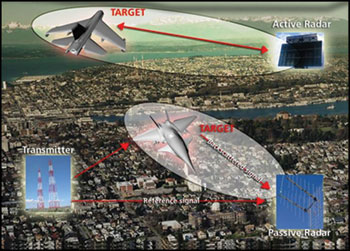 |
| AULOS, A Passive Covert Radar System | 2013-01-15 | Microwave Journal |
ICASSP 2014 - May 4-9, 2014 - Florence, Italy
Green
Radar State of Art: theory, practice and way ahead. A. Farina. - See
more at:
https://ieeetv.ieee.org/player/html/viewer?dl=#green-radar-state-of-art-theory-practice-and-way-ahead
Passive radar (passive coherent location, PCL) has been monitored and discussed repeatedly over the last decade by the whole aerospace and electronic systems community, including research institutions, universities, and industry. The tutorial will propose an introduction to the PCL system, showing its intrinsic characteristics and advantages with respect to traditional radars, such as, for instance, eco-compatibility and sustainability.Radar State of Art: theory, practice and way ahead. A. Farina. - See
more at:
https://ieeetv.ieee.org/player/html/viewer?dl=#green-radar-state-of-art-theory-practice-and-way-ahead
The state of the art will be presented by the AULOS© passive sensor, which is equipped with Uniform Circular Arrays (UCA). The system is based on Digital Beam Forming (DBF) technique and employs the contemporaneous reception of multiple sources of opportunity. Passive radar systems based on UCA need to identify the FM (Frequency Modulation) and DVB-T (Digital Video Broadcasting - Terrestrial) stations with extremely high accuracy, in terms of geographic position
and characteristics of the transmitted signal. As for the geographic position, it is mandatory to determine the azimuth of the station (Direction of Arrival, DOA); to achieve the goal, a very precise
goniometry strategy is needed. A priori information on the station position could be not reliable and not accurate enough; thus they need to be confirmed via goniometry. A relevant research item is the “blind” DOA estimation, i.e. DOA estimation not employing a priori information, in an environment heavily affected by multipath. Transmitter DOA is an input to the DBF algorithm.
In this contribution we also present a suitable receiving and processing chain for a DVB-T based Passive Bistatic Radar (PBR) system for both air and maritime surveillance. The presentation is focused on the experimental results achieved in the last year of R&D activities carried out in Selex ES in cooperation with the University of Roma “Sapienza” in the framework of the SeaBilla FP7 project. Specifically results achieved in several test campaigns held in Civitavecchia and Livorno, with both cooperative and opportunity (i.e. Automatic Identification System – AIS equipped vessels) targets will be shown.
The aim of this tutorial is to reflect the current state of the art of passive radar system development in the frame of security and defence, and promising hardware approaches, as well as advanced signal processing and future trends in passive radar.
- See more at: https://ieeetv.ieee.org/player/html/viewer?dl=&logged#green-radar-state-of-art-theory-practice-and-way-ahead
Background/Related:
- Di Lallo, A.; Tilli, E.; Timmoneri, L.; Battisti, T.; Campana, A.,
"Design, analysis and implementation of a passive integrated mobile
system for detection and identification of air targets," in Radar Symposium (IRS), 2012 13th International , vol., no., pp.32-36, 23-25 May 2012
doi: 10.1109/IRS.2012.6233284
Abstract: The integrated mobile passive AULOS® / ELT/332(V)5 system provides the detection and identification of potential air targets through the fusion of information from two sensors; it does not replace the typical active surveillance radar but it is an integrating element of the coverage of the airspace and/or of the coastal environment in areas where the traditional radar is difficult to properly work. Target detection is achieved by the AULOS Passive Coherent Location (PCL) developed by SELEX Sistemi Integrati, while target identification is ensured by the Communications Electronic Support Measures (C-ESM) system, named ELT/332(V)5, developed by Elettronica. A team of experts SELEX Sistemi Integrati/Elettronica has demonstrated the feasibility of an integrated solution where the fusion of the information collected by the two sensors can gather all their benefits and simultaneously overcome their limitations. In addition, we have identified the hardware characteristics of a motor-home that can host the mobile system and have started its implementation, as visible at the COL (Centro Operativo Logistico) at SELEX Sistemi Integrati facility in Rome, via Tiburtina.
keywords: {passive radar;radar detection;sensor fusion;air target detection;air target identification;communications electronic support measures system;integrated mobile passive AULOS/ ELT/332(V)5 system;passive coherent location;passive integrated mobile system;Mobile communication;Passive radar;RF signals;Sensor fusion;Sensor phenomena and characterization;C-ESM;PCL;integration},
URL: http://ieeexplore.ieee.org/stamp/stamp.jsp?tp=&arnumber=6233284&isnumber=6233281
Green
Radar State of Art: theory, practice and way ahead. - See more at:
https://ieeetv.ieee.org/player/html/viewer?dl=#green-radar-state-of-art-theory-practice-and-way-ahead
Radar State of Art: theory, practice and way ahead. - See more at:
https://ieeetv.ieee.org/player/html/viewer?dl=#green-radar-state-of-art-theory-practice-and-way-ahead
No comments:
Post a Comment